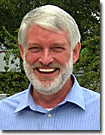Judges 2005

 | Dr. Alison North - Director of the Bio-Imaging Resource Center for the Rockefeller University in New York City, Dr. North is a cell biologist with expertise in virtually all areas of fluorescence microscopy. Throughout her career, Dr. North has applied a variety of optical microscopy techniques to her research on cell-cell junctions and membrane-cytoskeletal interactions. Among the many advanced optical microscopy techniques utilized by Dr. North at the Resource Center are laser scanning confocal, live-cell imaging, multiphoton, deconvolution, differential interference contrast, fluorescence recovery after photobleaching (FRAP), fluorescence resonance energy transfer (FRET), spinning disk confocal, laser microdissection, and a variety of techniques applied in digital image processing. Dr. North also has experience with transmission and scanning electron microscopy. |
 | Dr. George Patterson - A research scientist in the Cell Biology and Metabolism Branch at the National Institutes of Health in Bethesda, Maryland, Dr. Patterson is a widely recognized expert in fluorescent proteins. Among the accomplishments of Dr. Patterson in this arena are his pioneering work in quantitative imaging, including FRAP and FRET of fluorescent proteins, as well as the creation of the first useful photoactivatable version of green fluorescent protein (PA-GFP). Currently, Dr. Patterson is involved with research on the dynamics of endoplasmic reticulum, protein trafficking through the Golgi apparatus, and the dynamics of lipid raft markers. Among his areas of expertise in optical microscopy are all modes of fluorescence, multiphoton, photoactivation and photoconversion, as well as the advanced techniques mentioned above. |
 | Dr. Kenneth N. Fish - An Assistant Professor in the Translational Neuroscience Program in the Department of Psychiatry at the University of Pittsburgh, Dr. Fish uses knockout and genetic mutants that have subtle neuroachitectural abnormalities to study the functional consequences that mispositioning of a subset of neurons during development has on local circuitry. Studies using these mutants may be helpful in understanding aspects of the neuropathology that result in abnormal brain connectivity associated with schizophrenia, autism, and epilepsies. Optical microscopy techniques utilized in this research include confocal and multiphoton fluorescence imaging, as well as total internal reflection fluorescence (TIRFM) along with traditional widefield fluorescence methods. Dr. Fish also has experience with brightfield imaging modes, including phase contrast, differential interference contrast, and oblique illumination. |
 | Dr. Douglas B. Murphy - Professor Murphy is the Director of the optical and electron microscopy laboratory at the new Howard Hughes Medical Institute in Janelia Farm, Virginia. This resource is a core facility that provides equipment and services in fluorescence, confocal, and electron microscopy to laboratories throughout the research campus. Dr. Murphy's research interests include the dependence of microtubules in organelle transport and related microtubule behavior, including polymer annealing and the mechanism of binding microtubule-associated protein (MAP-2) on microtubule surfaces. He has also explored the mechanical and conformational requirements of the motor protein, kinesin. The core facility specializes in advanced fluorescence techniques (FRET, FRAP, TIRFM), confocal, multiphoton, and time-lapse in multiple fluorescence channels. Dr. Murphy has been a significant contributor to review articles and Java tutorials on the Olympus optical microscopy educational websites. |
Not Available in Your Country
Sorry, this page is not
available in your country.